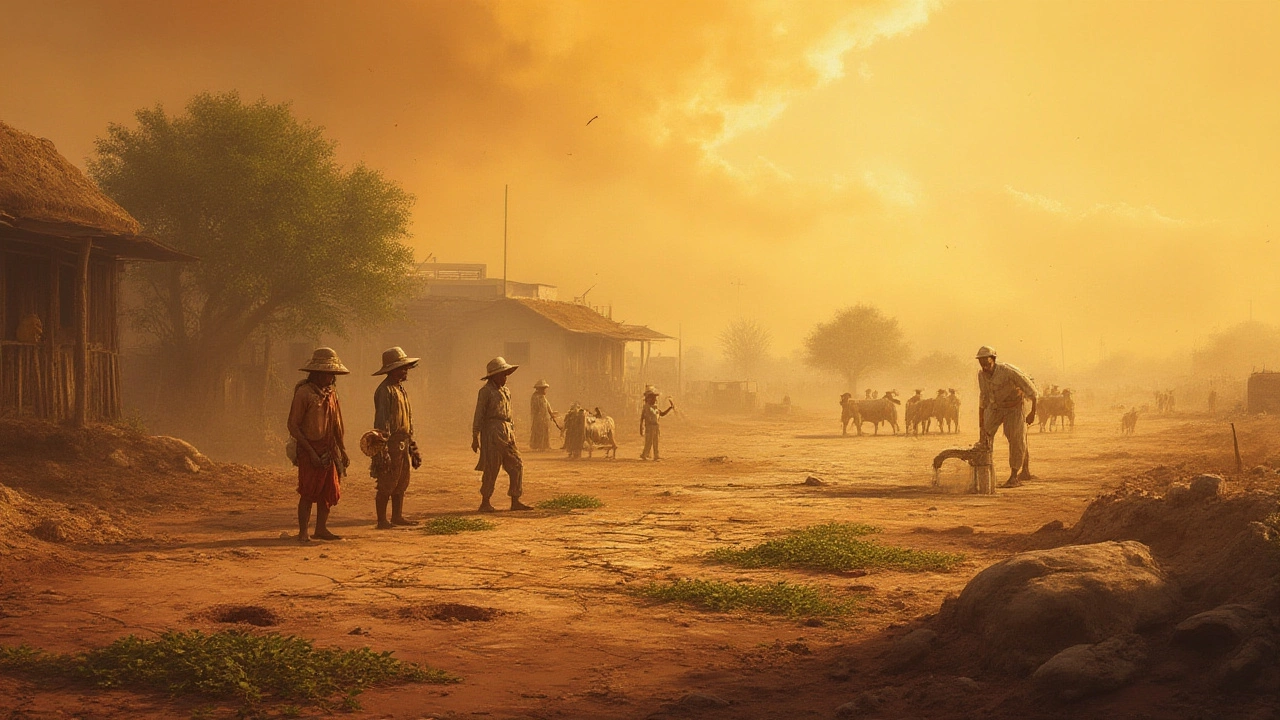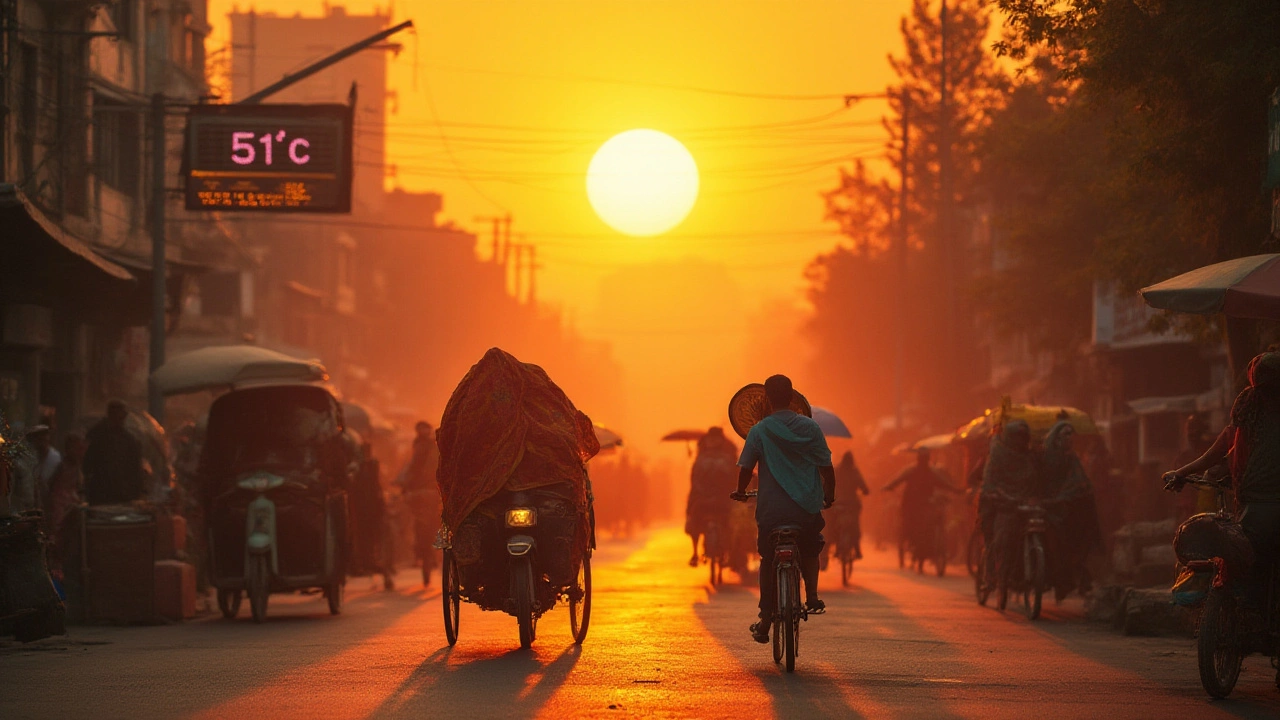The kind of heat India endures every summer is hard for people elsewhere to imagine. Across the country, people pack into whatever shade they can find, chugging water, fanning themselves, and sometimes even sleeping outdoors at midnight to escape the stuffy heat indoors. Just when you think you’ve experienced hot, along comes an Indian heatwave ready to redefine ‘scorching.’ The numbers get wild — so wild, you wouldn’t believe them until you see them on record. Forget your local hot day. In India, it’s not about sweating through your shirt; it’s about streets melting, rail lines buckling, and entire regions coming to a standstill under the sun’s relentless blaze. Ready to find out just how hot things can get?
The Hottest Temperature Ever Recorded in India
When it comes to the hottest record in India, there’s one number that stands out like a mirage on the highway: 51.0°C (123.8°F). This mind-melting temperature was measured at Phalodi, Rajasthan, on May 19, 2016. Rajasthan had worn the crown for extreme heat before, but Phalodi’s record almost defied belief. Imagine this: it’s so hot that the air itself burns, tarmac softens underfoot, and birds drop out of the sky from heat exhaustion. You can fry an egg on a car’s hood, and people literally try. Before anyone gets too used to the number, here are a few things to put it in perspective — most ovens preheat to about 175°C, but 51°C outdoor temperature is enough to give you heatstroke within minutes if you’re exposed and unprepared.
Here’s something even more nuts: before 2016, the existing record was 50.6°C (123°F), set at Alwar, Rajasthan, all the way back in 1956. Rajasthan, thanks to its dry climate, low rainfall, and big stretches of desert land, is always a contender for the heat trophy. If you look at the annual extremes, anytime India’s mercury touches 50°C, it’s somewhere in Rajasthan, often in May or June, when the sun seems to hang in the sky longer and meaner than ever.
Here’s a quick table to put these records in context:
| City/Town | State | Temperature (°C) | Date |
|---|---|---|---|
| Phalodi | Rajasthan | 51.0 | May 19, 2016 |
| Alwar | Rajasthan | 50.6 | May 10, 1956 |
| Churu | Rajasthan | 50.8 | June 1, 2019 |
| Ganganagar | Rajasthan | 50.0 | June 14, 1934 |
But don’t think Rajasthan is the only place feeling the burn. Northern India, especially the plains, gets battered by intense heatwaves every year — places like Delhi, Haryana, and Uttar Pradesh regularly cross 45°C as summer peaks. These extremes are not just numbers; they come with warnings from the Indian Meteorological Department (IMD) to stay indoors, ration water, and look after vulnerable folks like kids and the elderly.
What Causes Such Extreme Heat in India?
The answer is a cocktail of deserts, timing, and global warming, with a sprinkle of geography that’s both a blessing and a curse for India. Start with the Thar Desert in the northwest — Rajasthan’s infamous endless sand. That sand gets hammered by the sun from late March, absorbing every ounce of energy and slowly releasing it at night, which means the cool-down isn’t much to write home about.
Then there’s the timing. Indian summers kick into high gear after March, and by late April and May, the land is parched and the monsoon hasn’t arrived yet. This period creates a ‘heat dome’ effect — an area of high pressure traps warm air below and supercharges the surface temperatures. The winds coming in from Central Asia don’t bring any relief; they only stir up dust and hot air over northern India. And as April turns into May, the heat just builds up, sometimes spiking well above 45°C before the monsoon rains finally bring a break. In Phalodi’s record-breaking year, experts say an early, dry summer, weaker winds, and clear skies all played a part.
But there’s another factor making things worse: urban heat islands. Cities like Delhi, Jaipur, and Lucknow trap heat thanks to concrete, asphalt, and a sea of vehicles. High-rises block wind, and barely any trees survive the expansion. The result? Nighttime offers little relief, and day temperatures just keep climbing year after year. Mix in deforestation and shrinking water bodies, and the microclimate can push local heat to intolerable levels. Recent studies by the Indian Institute of Tropical Meteorology found that urban hotspots can average 2-5°C hotter than nearby open fields.
Climate change isn’t just a buzzword here — it’s showing up in the numbers. The IMD has noted a steady increase in the frequency and intensity of heatwaves. Over the past 30 years, the number of ‘severe’ heatwave days has shot up. In 2022, for example, India faced one of its harshest spring heatwaves in decades, with temperatures 3-4°C above normal in large parts of north and central India well before summer even started. That’s an extra punch when you already live with some of the world’s hottest weather.
Here’s a quick breakdown of how these factors line up:
- Geography & Thar Desert: Open land with little vegetation holds onto heat longer.
- Drought/Dry spells: Reduced water in soil and air means less cooling from evaporation.
- Urbanization: Concrete, asphalt, and buildings trap heat.
- Climate change: More greenhouse gases, less predictable weather, higher base temperatures.
It’s this blend of natural and man-made forces that brings India’s mercury so sky-high every year.

How India Responds: Stories, Stats, and Survival
Living through these epic heatwaves takes grit. There’s a legend in Rajasthan that tells of entire villages flipping their routines — folks sleep on the roof under the stars, wrap themselves in wet sheets, and get their work done before dawn. In cities, ceiling fans and water coolers are as essential as food. Kids soak in the tub for hours, markets open at sunup and close by noon, and everyone dreams of the first monsoon rain.
Government bodies like the IMD and the National Disaster Management Authority (NDMA) have turned heatwave awareness and survival into an annual campaign. In schools, teachers drill ‘drink water, rest in shade, check on elders’ before recess even starts. Businesses hand out electrolyte mixes to field workers. In regions like Telangana and Andhra Pradesh, where 2015’s fierce heatwave killed over 2,500 people, public parks become emergency cool shelters and ‘jal chabutras’ (water stands) pop up on street corners.
India’s healthcare system feels the sting, too. Hospitals prepare for a spike in dehydration, heat stroke, and kidney problems. Ambulances are often dispatched just to get vulnerable people out of the sun. And then, there’s a dash of local ingenuity — people use mud pots to cool water, hang wet sackcloth in doorways, and drape thick curtains over windows to block sunlight. Many swear by simple hacks: raw onions in your pocket supposedly fend off sunstroke, but science is less convinced.
The true impact shows up in the numbers:
- Each year, 2,000-3,000 heat-related deaths are reported, but experts suspect the actual toll is higher.
- Heatwaves between 1992 and 2015 killed about 22,000 people in India, according to the NDMA.
- Power consumption skyrockets as everyone cranks up air conditioning and water pumps, sometimes triggering blackouts on the hottest days.
- Wheat yields and food prices can be hit hard, especially if extreme heat hits before harvest or damages irrigation systems.
But the best stories are about tough people finding clever ways to keep cool. Some rural communities build thatched shade huts called ‘chhapars’ for livestock and travelers. Schools in Odisha created ‘heat action plans’ — tracking expected hot days and switching to morning classes to help students cope. Citizens in Gujarat organized neighborhood ‘chabeel’ stalls, offering free cold drinks to anyone passing by. These stories don’t make the news as much as the records, but they show the resolve to adapt, survive, and even laugh a little in the face of record-smashing temperatures.
India’s Heatwaves and Climate: Looking to the Future
If you look at the forecasts, it’s clear the heat isn’t letting up anytime soon. The IMD and World Meteorological Organization both warn that extreme temperatures will become more common. Cities and states are beefing up their response plans: Ahmedabad’s Heat Action Plan, the first of its kind in South Asia, has now become a model for other places, focusing on early warnings, public health outreach, and emergency cooling centers.
There’s more investment in research, too. Projects led by IITs and the Indian Institute of Tropical Meteorology are using satellite data and ground sensors to better understand and predict dangerous heat spikes. Policymakers push for greener cities — more parks, rooftop gardens, and ‘cool roofs’ that reflect sunlight instead of absorbing it. Solar reflective paint, better insulation, and sustainable water management are not just buzzwords now, but urgent priorities.
For regular folks, there are a few solid takeaways every year. Drink water constantly — not just when you’re thirsty. Wear light, loose cotton clothes; park yourself under a fan or tree when you can. Avoid strenuous activity during the afternoons. Fans and air conditioners help, but even a bucket of water and a wet towel can work wonders if you don’t have much else. And be a good neighbor: always check in on elders, young children, and others who might struggle during peak heat.
India’s hottest record might get broken again in the future. The planet is warming, and every year brings the possibility of a new high. But at the same time, people keep finding new ways to adapt, stay safe, and squeeze a little relief out of every muggy day until the monsoon clouds finally roll in. If you ever find yourself in North India during May or June, brace for some of the wildest weather on Earth — and stories you’ll never forget.
